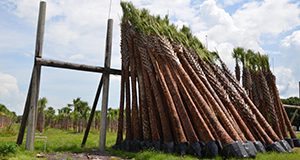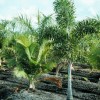 Palms are woody monocots characterized by the production of adventitious roots from the base of the trunk. Unlike the woody roots of dicots, such as oaks, gumbo limbo, and sea grapes, palm roots have no secondary thickening. Also, unlike trees, palms are incapable of repairing damage to their trunks. Most importantly, the life of a palm is dependent upon the continued good health of the single growing bud known as the meristem. Thus, if the palm bud is killed, the entire palm or the palm cane will eventually die. This 4-page fact sheet discusses harvesting and transplanting sabal palms, cropped transplants, and regenerated transplants. Written by Stephen H. Brown and Tim Broschat, and published by the UF/IFAS Environmental Horticulture Department, September 2017.
Palms are woody monocots characterized by the production of adventitious roots from the base of the trunk. Unlike the woody roots of dicots, such as oaks, gumbo limbo, and sea grapes, palm roots have no secondary thickening. Also, unlike trees, palms are incapable of repairing damage to their trunks. Most importantly, the life of a palm is dependent upon the continued good health of the single growing bud known as the meristem. Thus, if the palm bud is killed, the entire palm or the palm cane will eventually die. This 4-page fact sheet discusses harvesting and transplanting sabal palms, cropped transplants, and regenerated transplants. Written by Stephen H. Brown and Tim Broschat, and published by the UF/IFAS Environmental Horticulture Department, September 2017.
http://edis.ifas.ufl.edu/ep543
Tag: Palm Production
Field Production of Palms (ENH1210/EP471)
 Field production is the most practical means of producing large palm specimens, and it has several advantages over container production. Yield per acre can be maximized compared to many other woody ornamentals because of the columnar growth habit of most palms and their ability to survive transplanting with a minimal root ball. When dug and tied properly, many more palms can be loaded into a standard shipping container than could similarly sized trees. Palms also offer great versatility in the method of field harvesting.This 7-page fact sheet was written by Timothy K. Broschat, Alan W. Meerow, and Jack Miller, and published by the UF Department of Environmental Horticulture, April 2013.
Field production is the most practical means of producing large palm specimens, and it has several advantages over container production. Yield per acre can be maximized compared to many other woody ornamentals because of the columnar growth habit of most palms and their ability to survive transplanting with a minimal root ball. When dug and tied properly, many more palms can be loaded into a standard shipping container than could similarly sized trees. Palms also offer great versatility in the method of field harvesting.This 7-page fact sheet was written by Timothy K. Broschat, Alan W. Meerow, and Jack Miller, and published by the UF Department of Environmental Horticulture, April 2013.
http://edis.ifas.ufl.edu/ep471